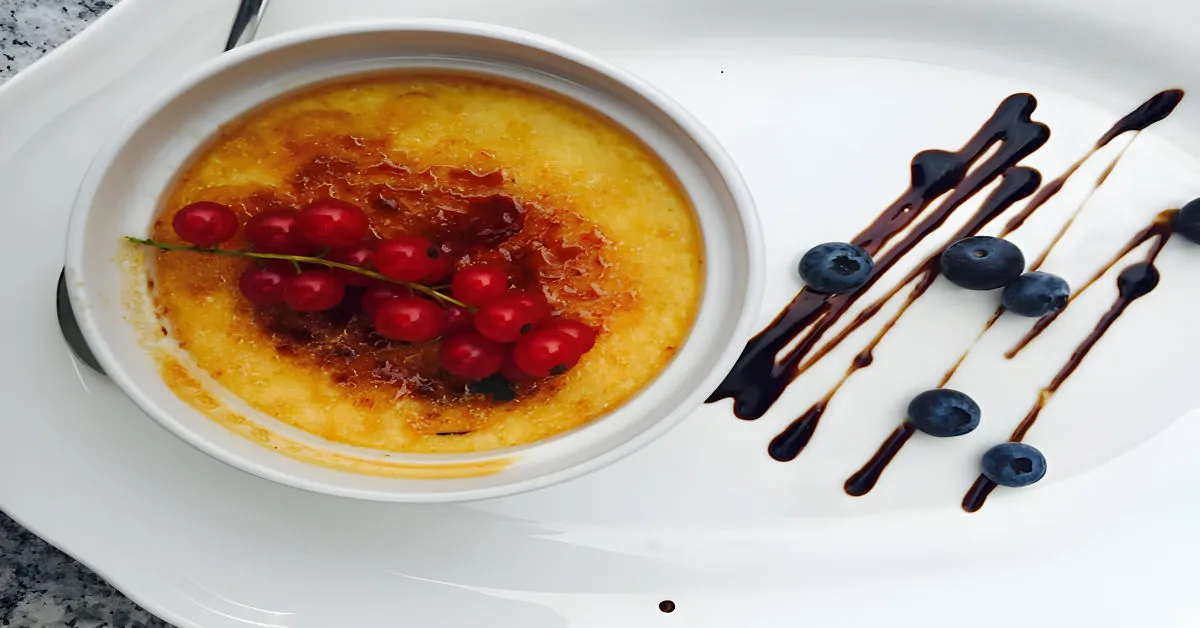Embarking on a culinary journey that marries the elegance of French cuisine with the bounty of the sea, this article delves into the exquisite world of Crab Brûlée. A dish that’s as intriguing as its name suggests, Crab Brûlée is a testament to the creativity and innovation found in modern kitchens. With its roots tracing back to the classic crème brûlée, this savory twist not only captivates the palate but also enchants the senses with its delicate balance of flavors and textures. From the creamy custard base to the caramelized sugar crust, each element of Crab Brûlée is a celebration of culinary finesse. As we unfold the secrets to crafting this sophisticated seafood dish, we’ll explore not just the recipe but the cultural tapestry that has made Crab Brûlée a beloved delicacy among foodies and culinary enthusiasts alike.
Introduction to the Delicacy of Crab Brûlée
Ah, Crab Brûlée recipe! Just the name itself evokes images of culinary elegance and gastronomic delight. But what exactly is this dish that’s been making waves in the foodie world? Well, folks, you’re in for a treat! Crab Brûlée is a stunning seafood dish that takes the creamy, dreamy essence of the traditional French dessert, crème brûlée, and gives it a savory makeover with the addition of succulent crab meat. Imagine the sweetness of fresh crab enveloped in a velvety custard-like base, all topped off with a thin layer of crackling caramelized sugar. Yes, it’s as delicious as it sounds!
Overview of Crab Brûlée as a Unique Seafood Dish
At its heart, Crab Brûlée is a celebration of contrast and harmony. The dish masterfully combines the delicate flavors of the sea with the rich indulgence of custard and the satisfying crunch of burnt sugar. It’s a culinary ballet, where each ingredient performs its role with precision and grace, resulting in a dish that’s both sophisticated and comforting. Whether served as an elegant appetizer, a luxurious main course, or a daring dessert, Crab Brûlée is versatile enough to dazzle at any dining occasion.
Brief History and Evolution of Crab Brûlée
The journey of Crab Brûlée from an experimental idea to a menu staple is as fascinating as the dish itself. Inspired by the classic crème brûlée, chefs began to explore savory variations of this beloved dessert, leading to the birth of Crab Brûlée. This innovative twist not only preserved the essence of the original but also introduced a new way to enjoy the richness of seafood. As it gained popularity, Crab Brûlée became a symbol of culinary innovation, blending tradition with creativity to create something truly unforgettable.
So, there you have it—a peek into the world of Crab Brûlée, a dish that stands at the crossroads of tradition and innovation. As we dive deeper into the nuances of preparing this delectable dish, remember, it’s not just about following a recipe; it’s about embarking on a culinary adventure that promises to delight and surprise with every bite. Stay tuned as we explore the essential ingredients and equipment needed to bring this dreamy dish to life in your own kitchen.
Essential Ingredients for Crafting Crab Brûlée
Creating a masterpiece like Crab Brûlée starts with gathering the right ingredients. Each component plays a pivotal role in shaping the dish’s final taste and texture. So, let’s dive into the essentials that make Crab Brûlée a true culinary delight.
Fresh Lump Crab Meat
The star of the show, without a doubt, is the crab meat. Opting for fresh lump crab meat is crucial as it brings a sweet, delicate flavor and a tender texture that canned versions just can’t match. It’s the sweetness of the crab that harmonizes beautifully with the creamy base, creating a symphony of flavors that’s hard to forget.
Heavy Cream and Eggs
The foundation of the custard base, heavy cream, and eggs, work together to create a rich, smooth texture that’s both indulgent and comforting. The eggs, in particular, are the binding force that holds the custard together, providing a silky backdrop for the crab meat to shine.
Seasonings and Sugar
A dash of salt and white pepper adds depth and enhances the natural flavors of the crab and custard. The granulated sugar, not just any sugar, plays a dual role—sweetening the custard and forming the iconic caramelized crust that’s the hallmark of any brûlée.
Required Equipment for Making Crab Brûlée
Now, having the right tools can turn a cooking challenge into a joyful and smooth experience. Here’s what you’ll need to create this dish:
Ramekins or Baking Dishes
Individual ramekins or small baking dishes are perfect for serving Crab Brûlée. They make for an elegant presentation and ensure that each serving has just the right ratio of custard to caramelized topping.
Kitchen Torch
The pièce de résistance of making any brûlée is achieving that perfectly caramelized sugar topping. A kitchen torch allows you to precisely melt the sugar, creating a crisp, golden crust that contrasts beautifully with the creamy custard below.
Gathering these ingredients and tools is the first step in your journey to creating an exquisite Crab Brûlée. With everything in place, you’re well on your way to impressing your guests or treating yourself to a luxurious culinary experience. Remember, the quality of your ingredients and the care you put into preparation will shine through in the final dish, making all the difference in achieving that perfect balance of flavors and textures. Stay tuned as we delve into the step-by-step process of bringing this delectable dish to life, ensuring your culinary adventure is both successful and enjoyable.
Step-by-Step Recipe for Crafting Crab Brûlée
With your ingredients and equipment at the ready, it’s time to embark on the culinary adventure of creating Crab Brûlée. Follow these steps closely, and you’ll be on your way to serving up a dish that’s as delightful to the palate as it is to the eye.
Preparing Your Crab Brûlée
- Mixing the Ingredients: Begin by preheating your oven to 325°F (165°C). In a medium bowl, whisk together the heavy cream, eggs, softened butter, 1/4 cup of granulated sugar, salt, and white pepper until the mixture is smooth and well combined. This is your custard base, the creamy heart of the Crab Brûlée.
- Folding in the Crab: Gently fold the fresh lump crab meat into the custard mixture. It’s crucial to do this carefully to maintain the lumps of crab for a delightful texture in every bite. The goal is to evenly distribute the crab throughout the custard without breaking it up too much.
- Dividing the Mixture: Lightly grease your ramekins or baking dishes with butter or non-stick cooking spray. Then, divide the crab and custard mixture evenly among the prepared dishes. This ensures that each serving has a generous amount of crab enveloped in the silky custard.
- Baking the Custard: Place the filled ramekins on a baking sheet for stability and carefully transfer them to the preheated oven. Bake for 15–20 minutes, or until the custard is set but still has a slight jiggle in the center. This is the sign of a perfectly cooked custard, creamy and soft.
Caramelizing the Sugar Top
- Cooling and Sugaring: After baking, let the ramekins cool on a wire rack for about 10 minutes. Then, sprinkle a thin, even layer of granulated sugar over the top of each custard. This sugar will transform into the signature brûlée crust.
- Torching the Sugar: Using a kitchen torch, carefully caramelize the sugar on each custard. Move the flame in a circular motion over the sugar until it melts and turns golden brown. This creates the crisp, crackly top that contrasts beautifully with the creamy custard beneath.
Serving Suggestions
To elevate the experience of enjoying Crab Brûlée, consider serving it with lightly toasted bread or crackers. These provide a delightful crunch and a way to scoop up the luxurious custard. The combination of textures and flavors makes for an unforgettable culinary experience.
Nutritional Information
Understanding the nutritional content of the dishes we enjoy is crucial for maintaining a balanced diet. Crab Brûlée recipe, with its rich ingredients and indulgent profile, might seem like a splurge at first glance. However, it’s also a dish that offers valuable nutrients, making it a worthwhile addition to special occasions. Let’s break down the nutritional aspects of this luxurious dish.
Nutritional Insights
A single serving of Crab Brûlée recipe, based on a recipe that yields four servings, provides an approximate nutritional breakdown as follows:
- Calories: 350 kcal
- Total Fat: 24 g
- Saturated Fat: 14 g
- Cholesterol: 230 mg
- Sodium: 500 mg
- Total Carbohydrates: 12 g
- Dietary Fiber: 0 g
- Total Sugars: 10 g
- Protein: 20 g
This dish is notably rich in protein, thanks to the generous amount of fresh crab meat, which is not only delicious but also a fantastic source of high-quality protein. Protein is essential for building and repairing tissues, making Crab Brûlée a dish that satisfies both your taste buds and your body’s needs.
The total fat content, particularly saturated fat, and cholesterol may be on the higher side, primarily due to the heavy cream and eggs. However, when enjoyed in moderation as part of a varied diet, Crab Brûlée can certainly find its place on your dining table during special occasions.
The relatively low carbohydrate content, with a modest amount of sugars, makes this dish an interesting choice for those who are mindful of their carb intake. While it’s not a low-calorie option, the luxurious experience of enjoying a Crab Brûlée is worth the indulgence every once in a while.
Advanced Tips and Variations
Mastering the art of Crab Brûlée not only involves following the basic steps but also understanding how to adapt and refine the recipe to suit different tastes and dietary needs. Here, we’ll dive into some advanced tips and explore variations that can help you customize this dish, ensuring it’s a hit with every diner.
Mastering Crab Brûlée
- Preventing Curdling: To ensure your custard remains smooth and silky, avoid overmixing once you add the eggs to the cream. Gentle folding is key, especially when incorporating the crab meat, to prevent the proteins in the eggs from tightening and causing the mixture to curdle.
- Alternatives to Fresh Crab Meat: While fresh lump crab meat is ideal for its flavor and texture, you can use high-quality canned crab meat in a pinch. Ensure it’s well-drained and gently fold it into the mixture to maintain some texture.
Dietary Adjustments
- Gluten-Free Options: Crab Brûlée is naturally gluten-free, focusing on the purity of ingredients. However, always check the labels of your ingredients to ensure they haven’t been processed with gluten-containing items.
- Dairy-Free Variations: For a dairy-free version, substitute the heavy cream with a full-fat coconut cream or another dairy-free alternative. This substitution may slightly alter the flavor profile but will still result in a deliciously creamy custard that complements the crab beautifully.
Ideas for Serving Crab Brûlée
Elevating the presentation and serving of Crab Brûlée can transform it from a simple dish to an unforgettable dining experience. Here are some ideas to inspire you:
- Refreshing Side Dishes: Pair Crab Brûlée with a light, refreshing side to balance its richness. A simple salad or the Din Tai Fung Cucumber Recipe can offer a crisp, clean contrast.
- Crunchy Accompaniments: Serve with a side of toasted, gluten-free bread or crackers to add a satisfying crunch that complements the creamy custard and caramelized sugar top.
Frequently Asked Questions about Crab Brûlée Recipe
Diving into the world of Crab Brûlée, it’s natural to have questions about perfecting this dish or adapting it to suit different dietary needs and cooking conditions. Here, we address some of the most common queries that arise, ensuring you’re well-equipped to create this delightful dish with confidence.
Preventing the Crab Mixture from Curdling
Q: How can I prevent the crab mixture from curdling during baking?
A: The key to preventing curdling lies in gentle folding and even temperature distribution. Ensure that the crab meat is gently folded into the custard mixture to avoid overmixing. Bake in a water bath to ensure gentle, even heat surrounds the ramekins, reducing the risk of curdling.
Using Canned Crab Meat
Q: Can I use pre-cooked or canned crab meat instead of fresh?
A: While fresh lump crab meat is recommended for its superior flavor and texture, you can use canned crab meat in a pinch. Ensure it’s well-drained and carefully picked through for any shells or cartilage. Keep in mind, the fresher the crab, the more delightful the final dish.
Alternatives for a Kitchen Torch
Q: What are some alternatives to using a blowtorch for caramelizing the sugar?
A: If you don’t have a kitchen torch, the broiler in your oven can be a great alternative. Place the sugared ramekins under the broiler, watching closely, until the sugar melts and forms a golden-brown crust. This method requires vigilance to avoid burning the sugar.
Adjusting for Dietary Restrictions
Q: How can I adjust the recipe to make it gluten-free or dairy-free?
A: To make Crab Brûlée gluten-free, ensure that all your ingredients are certified gluten-free. For a dairy-free version, substitute the heavy cream with a suitable dairy-free alternative like coconut cream or almond milk. Adjust the quantity to achieve the desired consistency of the custard.
Ingredients for Crab Brûlée Recipe
- 1 pound fresh lump crab meat: Carefully picked over to remove any shells and ensure the meat is of the highest quality. The freshness of the crab meat is paramount, as it’s the star of the dish, offering a sweet and delicate flavor that’s irreplaceable.
- 1 cup heavy cream: This forms the creamy base of the brûlée, contributing to the rich and velvety texture that makes this dish so indulgent.
- 3 large eggs: Eggs are crucial for setting the custard, providing structure and a silky smooth consistency that envelops the crab meat beautifully.
- 2 tablespoons unsalted butter, softened: Adds richness and depth to the custard, enhancing its luxurious mouthfeel.
- 1/4 cup granulated sugar, plus more for the topping: Sugar is used both within the custard for a subtle sweetness and as a crucial component of the brûlée’s signature caramelized crust.
- 1/2 teaspoon salt: Balances the sweetness and brings out the natural flavors of the crab and custard.
- 1/4 teaspoon ground white pepper: Adds a slight kick and depth of flavor, complementing the sweetness of the crab and custard.
Crab Brûlée is a dish that marries the elegance of French cuisine with the rich flavors of the sea, offering a unique and indulgent experience. Whether you’re a seasoned chef or a culinary enthusiast looking to try something new, this dish provides an opportunity to explore sophisticated flavors and techniques. By addressing these FAQs, we hope to have provided you with the insights and confidence needed to create this exquisite dish. Remember, cooking is as much about the journey as it is about the destination. So, don your chef’s hat, embrace the process, and prepare to delight in the sumptuous world of Crab Brûlée.


